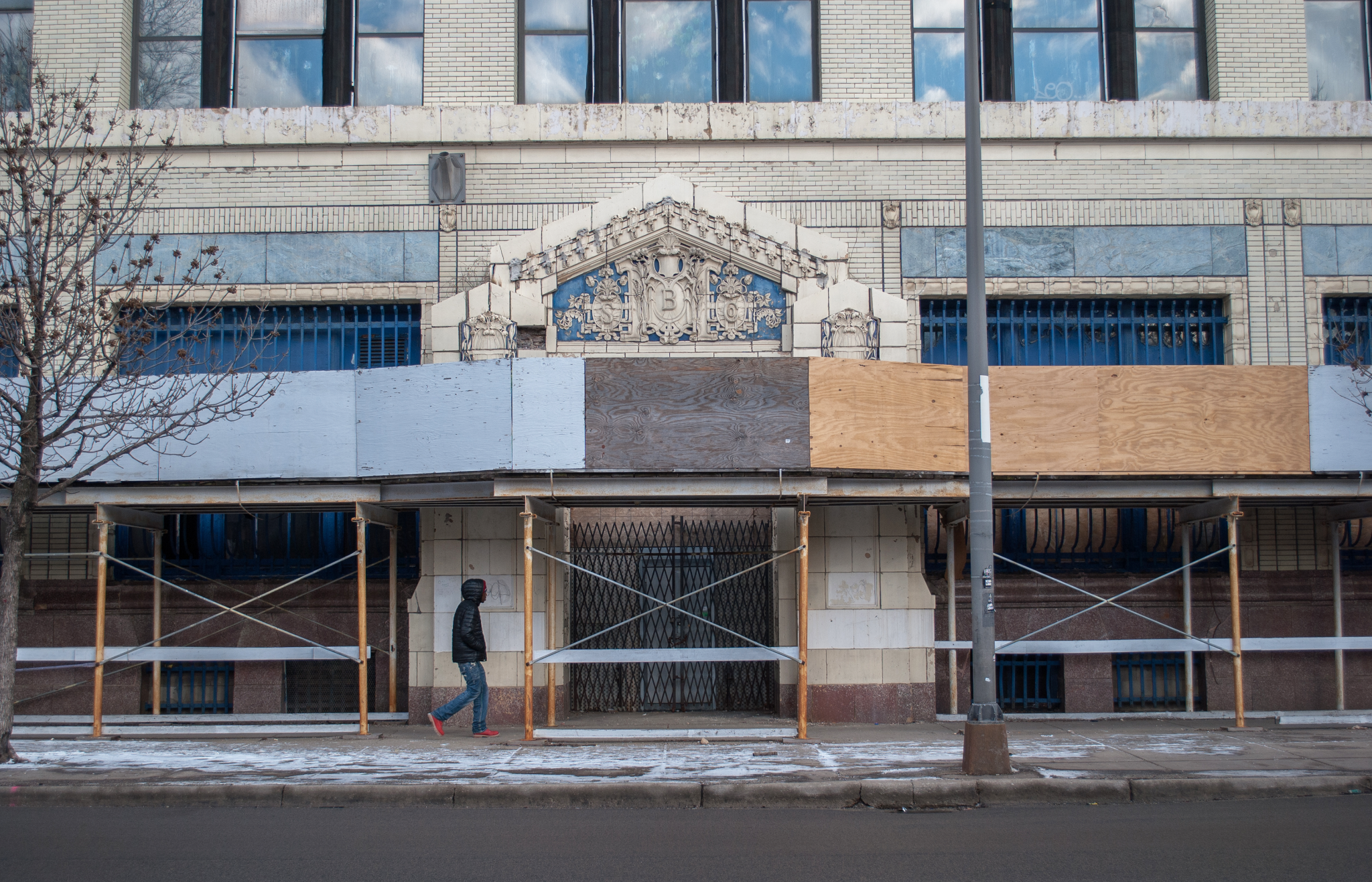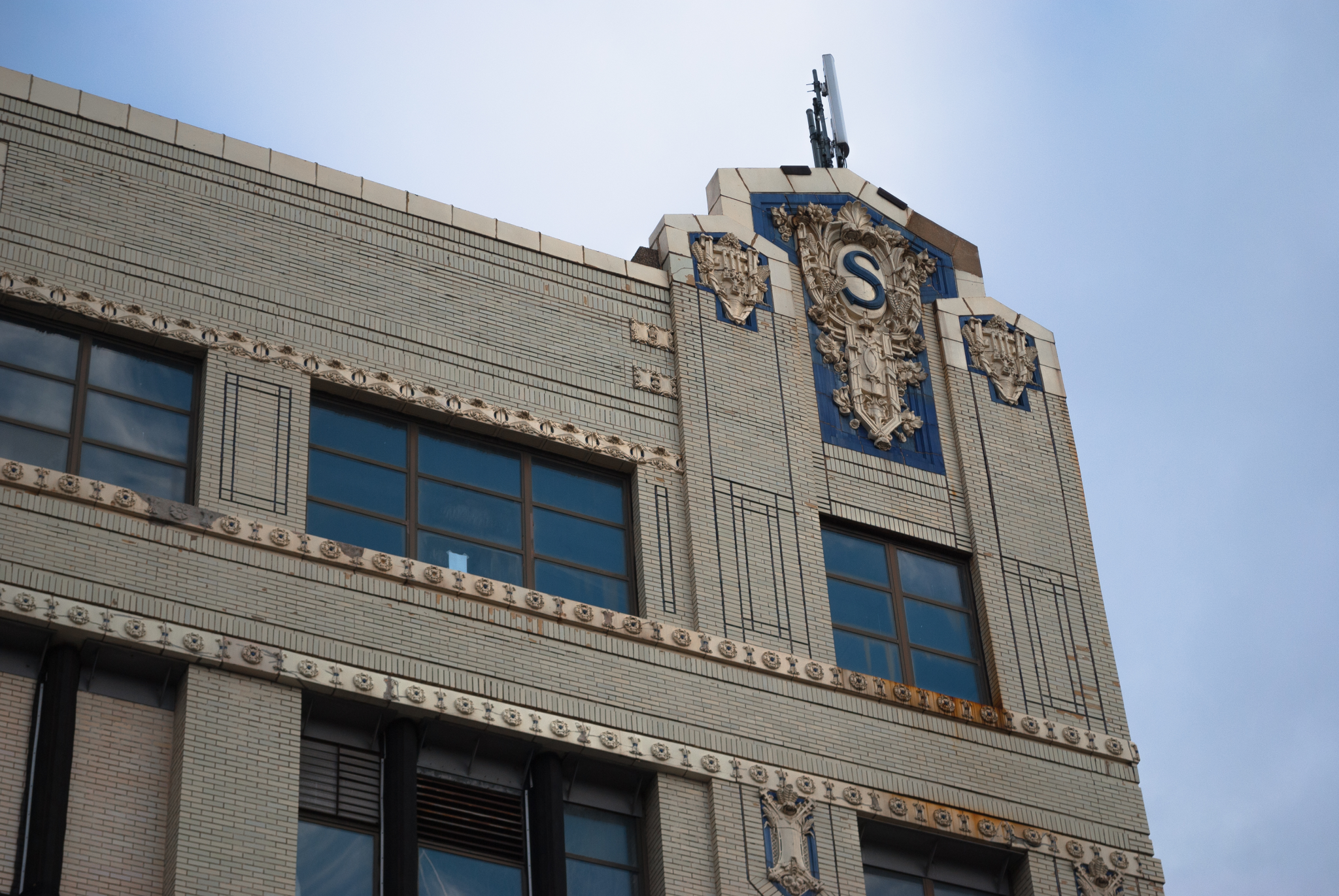Scaffolding lines the building to protect pedestrians from falling debris. Cigarette butts and decomposing leaves solidify into thick ropes at the base, impeding any entrance into the already gated, bolted, and locked doors. Despite the factory’s decaying facade, the creamy terra cotta still looks freshly glazed. When the sun hits the peeling blue paint, it’s easy to envision the once lavish details on the façade.
Paul Schulze left Germany in 1893. That same year, he founded what would later become the most modern baking business of its time, the Schulze Baking Company, at the intersection of Wabash Avenue and Garfield Boulevard.
In 1914, Chicago architect John Ahlschlager built the Schulze factory that still stands in Washington Park. The plant is designed in early Art Deco style. Curiously, though, Art Deco wouldn’t emerge for eleven more years in Paris, and sixteen more in America, according to Gardner’s Art Through the Ages. In addition to the outside, Ahlschlager, whose firm also designed what is now the Logan Theater, made sure the interior could house large-scale industrial baking by employing conveyor belts and assembly lines.
And it did. With this technology, Schulze revolutionized the baking industry. According to the Schulze and Burch Biscuit Company’s website (Schulze merged with the Burch Biscuit Company in 1933), Schulze earned titles for owning the largest bakery in the world and the highest-producing baking company in the country. The factory was listed in the National Register of Historic Places in 1982.
The factory was a good idea at a good time. At the 1911 convention of the National Association of Master Bakers, of which Schulze was the president, Schulze extolled the utility of industrial baking ovens, which were able to reach higher temperatures than household ovens. Housewives baking bread at home ended up producing half-cooked loaves laced with bacterial disease, Schulze said in his speech, claiming that these home bakers were “unquestionably committing murder.” This sensational claim reached the pages of the New York Times, and, according to the Schulze and Burch website, the commercial bread industry boomed.
Ninety years later, in 2004, the factory closed. The bread industry was in decline, a trend that some blame on the low-carb Atkins diet craze of the early 2000s, others on poor management in the industry. The plant has been vacant for over a decade, and the smell of baked bread has dissipated altogether. Landmark Illinois listed the building as one of its Most Endangered Historic Places in 2015.

Ghian Foreman, a Washington Park native and real estate developer, still remembers the fragrance from when the bakery was open. That’s partially why he bought the factory in 2006. The real reason for his $3.1 million purchase, however, relates to Schulze’s original vision for the bakery. The Schulze and Burch website claims that Schulze’s factory brought the initial industrial boom to Washington Park. Now Foreman, who is a partner with Maktub LLC and a board member at the Greater Southwest Development Corporation, hopes to bring a second boom to the neighborhood by reviving the factory. “Returning the building to its former glory could have a significant impact on the community,” he said.
But it hasn’t been easy: Foreman has been at work on restoring the building for ten years. Because of the factory’s status as a historical landmark, it is eligible for historic preservation tax credits. But during the economic downturn that began in 2008, government funding was limited; the Schulze bakery was swept to the sidelines. Foreman has had plenty of chances to sell the land and make a pretty penny, but he’s denied them all.
“I had to consider what was best for my family, as well as the community,” he says. “I would’ve made money but the community could’ve ended up in a worse place.”
This past fall, with Foreman’s approval, the American data center operator 1547 Critical Systems Realty invested over $130 million into Schulze Bakery. The company began transforming the building into a hundred-thousand-square-foot data center where a large number of computer servers will be housed.
“This is where the cloud lives,” Foreman explains, referring to the common term for internet data storage. He will be the managing partner of what will be called the Midway Technology Center. The center is expected to go live in 2017.
Foreman promises that the remaining 130,000 square feet of the unit will be utilized in the most community-oriented way—perhaps a hydroponics farming center or a training facility to teach adults and children coding, but he says it definitely will not be a storage unit. “We don’t know what it is that we are going to do, but we know that we have space that can be beneficial somehow, someway,” he says. “I would like it if that opportunity was also something that could be beneficial for the community, not just pure profit.”
The Schulze Bakery, then, will soon be more than a bittersweet reminder of the prosperous past. Once again it will exist as a result of an emerging enterprise in a neighborhood that lacks economic investment, using new ideas and new technology to bring jobs, traffic, and other opportunities to the community. “Everybody thinks that profit is just in dollars, but it’s a lot more than just dollars,” says Foreman. “It will generate jobs, taxes, and it could potentially spark other development in the community.”
But Foreman isn’t celebrating just yet, and he won’t be until the old Schulze factory reopens its doors. “It’s almost like raising a child,” he says. “I’ve been fighting with this thing for almost ten years, but it’s that important.”


Great work Ghian!
Virtually,
Harold L. Lucas
Urban preservationist
This is a great example of an entrepreneur with an attitude about wealth building that should be recognized, and emulated by the investment community and others. Do what is good for BOTH your self and also the best interest and well being of the community to which you belong. ” Do well and do good” Well done Ghian Foreman.
I am so pleased the Schulze factory has been saved and will reopen. I remember well the wonderful smells that would emanate from the bakery. I also remember the mini-loaves of bread that they would hand out to those who toured the bakery. Such wonderful memories. Although it won’t reopen in its original guise, I am glad that it will reopen with a new purpose.
With a name like Foreman, a mother like Jeannette, and a Grandmother like Marian, your vision and tenacity had to bring your project to fruition. Please make room within this grand facility for Art of the African Diaspora. Stephen “BlackButterfly” Carter